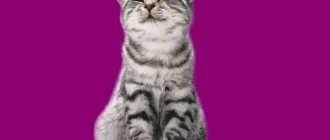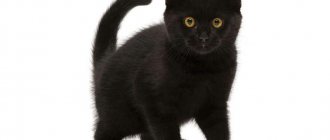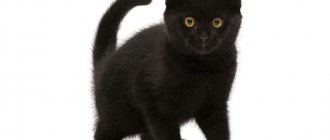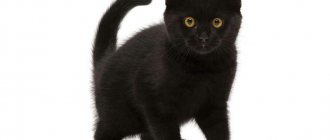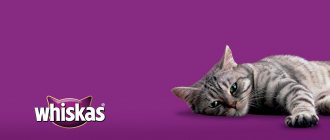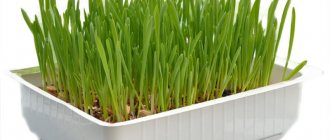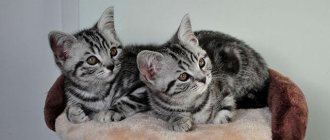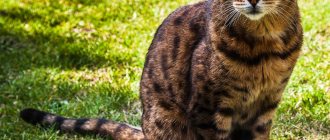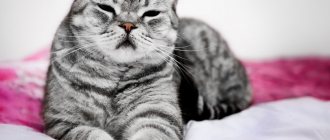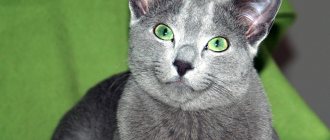WCF breed standards
| Weight | From 2.6 to 6 kg. Female cats have a lower body weight than female cats. |
| Appearance | Average height. Strong, stocky and massive constitution. Movements are confident and smooth. |
| Temperament | |
| Torso | Short, rounded and squat. |
| Head | Large, with thick cheeks and a strong chin. Large round whisker pads. |
| Muzzle | Round. |
| Chin | Strong. |
| Eyes | Large, round. Eye color matches coat color. In the USA and European countries you can see folds with orange, copper and golden eyes. |
| Ears | Small, pressed tightly to the head, with a characteristic fold. Set wide apart, directed towards the center of the head. The tips of the ears are rounded. |
| Nose | Short, wide, straight. Profile without stop. |
| Neck | Short and thick. |
| Frame | Compact |
| Wool | Short, thick, soft, shiny and elastic. Has high density. The texture is fleecy, but not woolly. |
| Color | All colors and patterns with any amount of white: plain (solid), “Chinchilla”, “Tabby”, “Calico”, “Bicolor”. |
| Limbs | Short, muscular. |
| Paws | Round and thick. |
| Tail | Medium length, flexible, reaching to the shoulders. It ends with a rounded tip without thickening. |
| Defects |
|
Curious kitten breed
The four-legged hero of an advertisement for a popular cat food is a representative of the British shorthair breed. The British are characterized by the following features:
- Medium and large sizes. Females weigh on average 3.5-6.5 kg, males’ body weight is 2-2.5 kg more.
- A large rounded head with full cheeks and a slightly pronounced rounded forehead, turning into a flat area between the ears.
- Large, round, widely and straight-set eyes, the shade of which is in harmony with the color of the coat. It comes in yellow, copper-orange, blue, and green. White animals often have heterochromia.
- Short wide straight nose.
- The ears are small, wide at the base with rounded tips. They are widely spaced from each other. They have a low posture.
- Short developed neck.
- A harmoniously balanced, developed body.
- Wide and deep chest.
- Shortened, developed back.
- Short strong limbs with rounded paws.
- Thick tail, wide at the base, of moderate length with a rounded tip.
- Short, dense coat, soft to the touch, with a thick undercoat.
There are many shade options for British fur coats.
The breed standard allows blue, lilac, chocolate, white, black, red, cinnamon, cream, tortoiseshell, tabby, color point and other types of colors. There are about a hundred of them in total. British Shorthair cats are a rare example of complete correspondence between appearance and character. These plush hulks, looking like cute clumsy bear cubs, are good-natured and tactful. They will never impose their communication. Such pets will fit perfectly into the lifestyle of any family. They are affectionate and incredibly loyal.
You can leave them alone without fear for the safety of property. In the absence of the owner, the British will prefer to enjoy sleep or watch what is happening outside the window. These animals get along well with children and other four-legged inhabitants of the home, from dogs to birds. Little Britons are very active and playful, but as they grow older they become calmer and more sedate.
Plain (solid, solid)
The monochrome uniform coloring of Scottish cats is considered classic by breeders.
The solid or solid color of the animal implies the absolute exclusion of any inclusions, small marks and specks of a different color. The tone is rich, even along the entire length of the coat. The most common used to be considered blue plain Scots. But today among the representatives of the breed there are many other variants of solid colors.
White
A Scottish cat with snow-white fur (without yellowness) looks luxurious. Possible eye colors are blue, amber, copper. According to the standard, eyes of different colors are allowed. The paw pads and nose are light pink.
Kittens may have markings of a different shade, which disappear after the first coat change. By the age of two, the coat of a white Scot should be crystal clear, without spots of a different color.
Black
The black cat has expressive yellow eyes. The nose and paw pads practically blend into the main color of the animal.
On the shiny bright coat of the Scottish beauty Ebony, 2-3 hairs of contrasting white color are allowed. The presence of large red or brown marks is not provided for by the standard.
Chocolate
The brown Scottish cat, also called chocolate, looks noble and impressive. The color of the coat contrasts with the animal's yellow, golden or copper eyes. The nose and paw pads are also dark brown.
Lilac (lavender)
The monochromatic lilac Scottish Fold has a gentle gray tint that smoothly turns into cream. The nose is slightly brownish, the paws on the bottom are the same color as the coat, in harmony with the main color of the pet. This lilac-lavender color goes well with eyes of copper, amber or orange shades.
Red (red)
Red or ginger color is a rare and valuable color of the Scots breed. The fiery edge is combined with burning amber irises. Pads and nose to match the dominant color.
The tail of kittens and adult animals is not very evenly colored. This deficiency does not disappear with age and is allowed by the standard. And the presence of marks on the head and limbs that remain after reaching the age of two are considered a deviation from the norm.
A red Scottish straight-eared cat can give birth to kittens not only with erect ears, but also with ears pressed to the head.
Cream
The cream or peach fold cat is infinitely elegant and beautiful. The delicate background of light fur, bright golden eyes and a pinkish nose give the pet an irresistible appearance. The pads on the paws are also pink. An animal with this color is similar to a red Scotsman, but its coat color is a shade lighter.
A peach fold kitten may have a blurry, fuzzy pattern on its paws and tail that does not disappear with age. This is not critical for a purebred pet, but leopard markings are absolutely unacceptable.
Faun (deer)
There is another unique color of Scottish fold cats with an interesting name - fawn, which means “young deer”. The nose and pads on the paws of these beauties are beige-pink.
Cinnamon
Cinnamon is a lighter and more delicate color than chocolate, but darker than red. The nose and paw pads of such animals are brown, beige or pink.
Blue color (blue)
The gray or blue Scottish cat has very beautiful amber eyes. The coat tone of a purebred pet can belong to any range of gray - from the lightest (blue) to completely dark (blue). At the same time, each hair is saturated and well colored, without streaks.
The nose and pads practically do not differ in color from the plain coat.
A gray Scottish Straight cat may be marked with a few streaks and drawings in childhood. But as they grow older, these color flaws go away.
The history of whiskey color
A common feature of all the cats that starred in the commercial is silvery fur with spectacular tabby stripes and markings. The color immediately received the name whiskey and has existed in this form for several years.
This is interesting! Among domestic cats, individuals with silver coat color are rare.
The history of the origin of the silver color began no more than a century and a half ago. There are references to Mrs. Valance, the owner of a short-haired British kitten with a silver color that was completely unique for that time. The female kitten was named Chinnie. She was matched with a Persian cat Fluffy with a similar coat color, and the breeder began experimental matings. Of the two litters, only one cat named Beauty left a mark on the breed. Her offspring included Silver Lambkin (1889), which experts later recognized as the first silver cat in history and was officially registered in 1894.
The important role of this cat in the further development of silver, chinchilla, shaded and shaded varieties is recognized by all felinologists. Among his contemporaries, Silver Lambkin earned the title of “father of the breed”, since it was he who became the founder of many lines. The famous cat died of old age at the age of 17 (1906) and the next day this news was on the front pages of all the world's newspapers.
The ancestors of the current Whiskas representatives had a color that was far from modern. In a small group, it was difficult to achieve a clean transition of a unique color from generation to generation. Until the 30s of the last century, these cats were considered a rarity, and their fur constantly “disappeared” into foreign shades. Much later, breeders accumulated enough material for generalization, geneticists took up the problem, and silver whiskey spread to other breeds. Then the British shorthairs got it, and food manufacturers liked it so much that they used a cat with an unusual color for filming a popular commercial.
This is interesting! If British animals acquired a whiskey coat color during the development of the breed, then other representatives of the cat family were born with this color. For example, Scottish Fold cats are also represented in the elite group of Whiskas color and are very popular among breeders.
British Whiskas cats: types of colors
In British Whiskey cats, the main tone is silver, but the pattern can be made in different coat colors. The colors of British silver tabby cats are encoded with the letter s (silver), which is added after the main color of the color.
Whiskey British (British silver tabby) can be of the following types:
- black silver ticked/spotted/striped/marbled BRI ns 25/24/23/22;
- blue silver black silver ticked/spotted/striped/marbled BRI as 25/24/23/22;
- lilac silver black silver ticked/spotted/striped/marbled BRI cs 25/24/23/22;
- chocolate silver black silver ticked/spotted/striped/marbled BRI bs 25/24/23/22;
- cinnamon silver black silver ticked/spotted/striped/marbled BRI os 25/24/23/22;
- fawn silver black silver ticked/spotted/striped/marbled BRI ps 25/24/23/22;
- red silver black silver ticked/spotted/striped/marbled BRI ds 25/24/23/22;
- cream silver black silver ticked/spotted/striped/marbled BRI es 25/24/23/22;
- tortoiseshell silver ticked/spotted/striped/marbled BRI 25/24/23/22;
- bicolor silver ticked/spotted/striped/marbled BRI 25/24/23/22;
- silver color points ticked/spotted/striped/marbled BRI 25/24/23/22.
Other breeds that have this color
In addition to British cats, other varieties have colors similar to Whiskas.
| Breed | Short description | |
| Scottish Fold or Scottish Fold | Scottish kittens are in many ways similar to their British counterparts, differing from them only in small ears curved inward and a narrower muzzle. Representatives with brindle color have vertical narrow stripes, a striped pattern on the tail, and the letter “M” on the forehead. The eyes and nose are outlined with a dark line | |
| Siberian | The common coloring of this breed is Siberian brindle tabby with thin, clear lines running from the back to the belly. There is also a torby color, in which silver, chocolate or blue brindle is combined with cream spots | |
| Persian | The striped color of the Persians is called the “patchwork pattern.” Characterized by narrow lines, paws and tail in bracelets and chains on the chest | |
| Maine Coon | Cats of this breed often have patterned colors. Among them there are also striped ones, the most popular of which are red and silver brindle |
What kind of health does the Scotswoman have?
It is very important to vaccinate such pets on time.
The British cat from the Whiskas advertisement is considered a naturally bred breed. If you provide your pet with proper care and feeding, and protect it from stress and cold, then health problems will not arise. However, among hereditary diseases, hypertrophic cardiomeopathy occurs. The disease manifests itself after one year of age, so the owner should conduct a preventive examination of the pet 1-2 times a year. Like other felines, razors are susceptible to infections and parasitic infestations. Therefore, it is necessary to vaccinate in a timely manner and treat the animal with antiparasitic agents.
Character and behavioral characteristics
Even in one litter you will not find two kittens with the same character. One may behave very impulsively and even aggressively, another will be gentle and affectionate, and the third will be overly inquisitive. However, there are character traits that characterize almost all Scottish Fold cats. The description of the breed confirms that these are temperamental animals, ready to make contact with humans. And that his character will depend on his upbringing.
The Scottish Fold is different:
- a highly developed sense of independence - there are even egoists among them;
- selective memory - the cat learns only that information that is interesting to it and will bring benefits;
- awareness of personal significance and increased self-esteem - she will not tolerate a bad attitude towards herself, and if something happens, she will also take revenge on the offender by making a puddle in her favorite shoes;
- unobtrusiveness - this is not a breed that will seek the owner’s attention at any cost;
- moderate playfulness - loves outdoor games, especially if the beloved owner participates in them;
- dislike of fights - the purr does not instigate quarrels and conflicts, he prefers to leave the conflict zone;
- good hunting qualities - moves quickly and always takes its prey by surprise;
- patience - ready to wait for hours for prey in a secluded place;
- excellent sense of day and night - they prefer to follow a certain regime and do not like to deviate from it;
- with a pronounced reflex of tameness - they become attached to both the person and the place of residence.
Pets don't like change. They get used to their new home pretty quickly. Moving is always associated with stress for them. A well-studied environment helps the cat navigate in space. Pets can be sensitive to even the rearrangement of furniture, and even more so the redevelopment of a well-known house, which, with their characteristic selfishness, they consider their property.
The Scottish Fold is an exclusively domestic cat. She feels great in an apartment or house. But from time to time you can take her out for a walk.
What commercials feature cats?
In 2014, there were more than two million cat videos on YouTube. The cumulative number of views was about 26 billion. Along with the themes of “humor” and “sex,” cats have become another driver of advertising effectiveness.
“Judging by the latest research from advertising and marketing specialists, seeing our furry friends in videos increases the number of views of advertising materials,” says Irina Bavykina, founder of the Cheshire Cat advertising agency.
“Cats in advertising allow you to attract greater audience attention to the product or service being promoted, or a larger audience in quantitative terms.”
In 2011, Canadian advertising company JohnSt released a humorous video about the creation of supposedly the first agency in history to use exclusively cats in its videos. For this purpose, marketers have come up with a special term - catvertising. “Cats are the most popular media on the Internet,” say representatives of JohnSt.
The British milk producer Cravendale tried to advertise its product with the help of people, pirates, Muppet dolls, animated livers, and cows, but success came to the company only when cats were involved in the video. Brand awareness after advertising increased by 10%, sales - by 8%. The video now has almost 8.5 million views.
Cats successfully cope with advertising not only for pet products or milk. In February 2014, the automotive giant Mercedes released a video in which “the most aerodynamic production car in the world,” the Mercedes Benz CLA, is advertised by a lazy cat accompanied by classical music.
The company ended 2014 with a record 1,650,010 vehicles sold, increasing sales by almost 13%.
A year earlier, Toyota also used a cat to promote the Corolla model in New Zealand and Australia. Pets don't always like to travel in cars, so marketers wondered what cats would be willing to do if they fell in love with driving.
In the video, within 90 seconds, the cat spends his nine lives in order to be inside the treasured car. The video has already been watched by more than 1.7 million people. And the Corolla became Australia's best-selling car of 2013.
Cats participated in advertising for the IKEA store, Puma sneakers, Arlistan coffee, KIA Picanto cars and many other products. In 2013, the British telephone operator O2 launched the “Be a Dog!” advertising campaign, the main character of which was a cat. The company encouraged viewers to go beyond their usual boundaries using the example of a cat who suddenly wanted to become a dog.
The video received more than three million views on YouTube and the highest number of shares in the UK in a month. About 40 parodies of it were released.
In 2005, when cats were just gaining popularity, the American mortgage company Ameriquest presented a series of commercials during the Super Bowl - a day comparable in its significance to a national holiday for Americans. Traditionally, this is also the main day for advertising, which will be seen by the whole country. The videos show different situations in which a person can draw incorrect conclusions about what happened.
The campaign slogan was: “Don't jump to conclusions. We wouldn't." With this statement, Ameriquest assured people that it would not judge their creditworthiness too quickly, giving them a better chance of getting a mortgage. The best of the four videos was the one in which the cat took part. In popularity, it overtook the Pepsi advertisement that aired at the same match. The video later won an award at the Cannes Lions festival.
“Cats will have the greatest effect in advertising FMCG (public consumption) goods - everyone needs such products, information and “cuteness” spread across the Internet quickly,” says creator Irina Bavykina. — The audience is not as important here as the product that the cat is advertising. But like any other advertising, videos with cats may not work - it all depends on the creativity and ideas of the authors.”
“If everything is done correctly, then photos or videos of cats will increase the popularity of any blog,” comments blogger Ekaterina Tsoilik (8,976 subscribers). - But a lot depends on the animals themselves - everyone loves fat, fluffy and lazy cats. But not everyone likes bald sphinxes, so it’s unrealistic to get likes with them. The most popular breeds are the British and Scottish Fold.”
Colors of Scottish cats: photos, table, descriptions
If you ask the average person what color Scottish cats are, he will certainly answer that they are gray (the color among professionals is called blue). This is a common color of Scottish cats. But today the variety of colors is very large. Therefore, when asked what color Scottish cats are, you must boldly answer: any! To get such a wide palette, Scots had to be crossed with other breeds. Today, interbreeding is not encouraged, because cats already have the necessary set of genes.
In Scottish cats, two genes predominate, responsible for black and red coat colors. Each of them can act as a dominant (suppressing weaker genes) and recessive (suppressed gene). And there is a third diluent gene, responsible for the saturation of the pigment. Combining in a certain order, these genes can give completely unimaginable coloring. If you are interested in the topic of the genetics of the colors of Scottish cats and what coloring results from crossing, come here. And we will continue.
The presence of one color or another in a Scottish kitten cannot always be determined in the first weeks of life. This is not the final shade yet, because the coloring becomes brighter and more pronounced only when the coat is replaced by an adult during the baby's molt. This happens around six months of age. But up to 2 years, the shade may still change slightly.
Features of feeding
Whiskey shavers are not fussy eaters. Veterinarians do not recommend feeding your pet store-bought sausages, smoked meats, sweets, salty and fried foods. You can give liver, but not more than once every 7-10 days. The diet should include lean meats, boiled fish (1 rub. every 10 days), hard-boiled egg yolk, cottage cheese and kefir. As for industrial feeds, veterinarians recommend premium food - Royal Canin, Trainer, Hills, Advance.
There is probably no person who has never seen an advertisement starring a kitten and Whiskas food. And now many are interested in the name of the cat breed from the Whiskas advertisement. After all, the baby is so cute that you want to pick him up and cuddle him. Let's study the presented materials and figure out who is starring in the commercial.
- 1.1 1.1 Types of tabby colors
- 1.2 1.2 Features of the classic patterned color
Scottish cat color chart
Cats of the Scottish breed (Scottish Fold, Highland Fold, Scottish Straight and Highland Straight) are subject to the international color classification. It has symbols - numbers and letters. The code consists of:
1. Capital letters denoting the breed.
2. Lowercase letters indicating the primary color (blue, chocolate, etc.).
3. Pairs of numbers indicating the type of color (shaded, harlequin, Siamese, etc.) are numbers from 1 to 35.
4. Tail length - numbers from 51 to 54.
5. Eye color - numbers from 61 to 67.
6. Another additional pair of numbers can indicate the shape of the ears - 71 (straight ears of the Scottish Straight) and 73 (dropping and forward-curved ears of the Scottish Fold).
XXX.xx.NN.NN.NN.(NN)
xx - lowercase letter color designations:
| Designation | Colors |
| A | blue |
| b | chocolate, brown, chestnut (chocolate, brown, Havana, champagne) |
| With | lilac, lavender (lilac, lavender, platinum) |
| d | red, flame (red) |
| e | cream (cream) |
| f | tortoiseshell, patch (tortoiseshell) |
| g | blue-cream, blue-tortie (blue cream, blue tortoiseshell) |
| h | chocolate-tortie (chocolate tortoiseshell) |
| j | lilac-tortie (lilac tortoiseshell) |
| n | black, ebony, seal, sable, ruddy (black, ebony, seal, sable, wild) |
| o | sorrel, cinnamon, honey (sorrel, cinnamon, honey) |
| p | beige fawn (yellow-brown, beige) |
| q | sorrel tortie (red-brown tortoiseshell) |
| r | beige fawn tortie (beige tortoiseshell) |
| s | silver, smoke (silver, smoky) |
| w | white (white) |
| x | unregistered (unregistered color) |
| y | golden (golden) |
NN.NN.NN.(NN) - values of pairs of digits (up to three main and one auxiliary), starting with 0:
| Designation | Decoding |
| 01 | van (van) |
| 02 | harlequin (harlequin) |
| 03 | bicolour (two-color, bicolor) |
| 04 | mitted/white point (with white markings for color points) |
| 09 | little white spots (white spotting 1-2 cm) |
starting with 1:
| Designation | Decoding |
| 11 | shaded (shaded, i.e. 1/4 of the top part of the hair is darkened) |
| 12 | tipped, shell (veiled, i.e. 1/8 of the top part of the hair is darkened) |
starting with 2:
| Designation | Decoding |
| 21 | tabby, agouti (striation, agouti factor) |
| 22 | blotched, marble |
| 23 | mackerel, tiger (mackerel, tiger) |
| 24 | spotted (spotted) |
| 25 | ticked (ticked or Abyssinian) |
starting with 3:
| Designation | Decoding |
| 31 | burmese (Burmese) |
| 32 | tonkinese (Tonkinese) |
| 33 | himalayan or siam (Himalayan, Siamese, point) |
| 34 | singapura (Singaporean) |
| 35 | abyssinian (Abyssinian) |
starting with 6 (eye color):
| Designation | Decoding |
| 61 | blue |
| 62 | yellow, golden (yellow, orange, golden) |
| 63 | oddeyed |
| 64 | green |
| 65 | burmese (eye color of Burmese cats) |
| 66 | tonkinese (eye color of Tonkinese cats) |
| 67 | himalayan or siam (eye color of Himalayan and Siamese cats) |
For example, a fold-eared cat of color ps 24 is a cat of silver spotted fawn color. Thus, as you can see, the color code is formed from letters and numbers, but there are a lot of variations in the colors of Scottish breed cats, because... various factors combine to form countless variations. Within the scope of this article it is impossible to show absolutely all the colors of Scottish cats, cats and kittens.
How much does a cat “as advertised” cost and where can I buy it?
This is a fairly common breed, so there will be no problems with purchasing the same kitten as in the advertisement of the famous cat food. You can buy an animal at a bird market, at a pet store, through an advertisement, or at a nursery.
When purchasing a cat from your own hands, there is a high risk of getting a mongrel pet instead of a purebred one, and one that is not very healthy. To prevent this from happening, it is better to buy British dogs only in official nurseries.
When choosing, it is recommended:
This is not the most expensive breed, so almost anyone can become the owner of such a cat. The price of British dogs consists of many factors: the popularity of the nursery, the title of the parents, compliance with standards, region, color. If you do not plan to breed British dogs or participate in exhibitions, you can purchase an animal without the makings of a future champion or qualities attractive for breeding. Such a purchase will cost several tens of thousands of rubles. Show-class babies cost 35-50 thousand rubles.
The cats and kittens in the cat food commercials are whiskey colored. However, this is a conventional name for coat color. In order for the on-screen image of cats to become real, it is useful for the future owner to find out what kind of breed it is on the packaging of bags of food, and what the reference specimen looks like. And also understand what kind of health your pet has, the features of caring for it and feeding it.
The famous naturalist Harrison Way, the founder of the breed standards system, organized the world's first cat exhibition in 1871, and already in 1889 the white British cat was recognized as a purebred.
Acquaintance
So, I won’t bother you with a long wait, and... drum roll: the cat from the Whiskas ad is a British Shorthair. Today, all over the world, British cats are considered the most popular.
The cats, or rather the kittens from the commercial, were born and raised in Germany in a nursery called “Silver Treasure”. The kittens of this nursery have become recognizable since 2003. Can you imagine how much time has already passed? But it was the British with the “silver tabby” color that viewers fell in love with. You can often find the color “brindle” or “merle tabby”. A breed with this color is considered new, bred by pet lovers, not by felinologists. It is noteworthy that in recent years a characteristic feature has been the naming of a cat’s breed after the name of the food it advertises.
Having learned what breed of cat is in the Whiskas advertisement, many people rush headlong to buy it. But first you should find out the prices. Thoroughbred British are unlikely to be handed over to “good hands” for free. Imagine, the cost of a kitten from a commercial (not the same one, but a similar one) varies between 25-100 dollars. Purebred young pets with a rare color can cost about 250-350 dollars.
Why did British Shorthairs win the tender to appear in the Whiskas commercial?
The cat from the Whiskas advertisement is the face of the brand. Why was this breed given such honor? Everything is so banal. When a TV viewer sees such a baby, he understands that the “British” is the personification of an ideal (in every sense) pet: so calm, sweet, balanced, well-groomed and unrivaled. This breed is capable of unbalancing (in a good way) even the most unemotional and secretive person: you just want to cuddle the baby.
The British Shorthair breed was chosen because it has the following qualities:
- ideal composition, harmony and proportionality of the body;
- dense and thick tabby coat resembles a plush blanket;
- adult Scottish Straight animals and kittens are equally attractive to television viewers;
- absence of signs indicating the exclusivity of the breed.
As already mentioned, representatives of the breed for advertising are raised in a German nursery. The key to success is to comply with the following laws:
- good heredity;
- proper care;
- balanced, proper nutrition;
- constant examination by veterinarians;
- natural selection.
Only by complying with the above standards do breeders raise energetic, attractive, healthy pets. Moreover, kittens with the most touching and sweet faces are selected for advertising.
Other stars of the blue screen
- The Gourmet Gold commercial features a luxurious Persian chinchilla.
She is wrapped in a fluffy, soft-to-the-touch white fur coat, dusted with “silver.” The cat's real decorations are blue or emerald eyes and a fluffy fan tail. An upturned nose reveals a capricious character that requires increased attention. Chinchillas are very affectionate, devoted creatures who adore children, but are quite selfish and jealous - they will not tolerate other cats. Persian beauties move around the house silently, without destruction, and in the absence of their owners they quietly mourn at the window;The Persian chinchilla has white fur with a slight silver coating.
- The creators of Purina One food chose the good-natured giant Maine Coon as the “face” of their advertising campaign.
Everything about his appearance demonstrates strength and primitive beauty: a strong physique, a strong-willed chin, tassels on his ears, a lush frill and a bushy tail. Maine Coons are companion cats that are always in the thick of things at home. They love communication, play with babies and are friends with other pets. Despite their formidable appearance, these are the sweetest, affectionate and very patient creatures that remain playful and curious into old age;A lively mind allows Maine Coons to carry out many commands
A Bengal cat starred in the Perfect Fit Active ad.
She has an athletic build and predatory plasticity. Its silky fur of an unusual color for a domestic purr is reminiscent of its wild ancestors - Asian leopard cats. From them the Bengali woman inherited a love of water and walks in the fresh air. At any age, these cats remain hyperactive, inquisitive and cheerful. They become very attached to their owner and love to chat with him about life. Bengalis are very observant, smart, self-confident and are ready to do a lot of mischief to achieve their goals;
Tired of his exploits, the Bengal fidget will peacefully fall asleep next to its owner under a warm blanket
The Russian Blue was featured in the video introducing Sheba food.
Cats of this breed are graceful, aristocratic, self-sufficient and clean. Their powers of observation allow them to read their owner’s mood in their eyes and decipher their gestures. They do not skimp on showing feelings for their household members, but they also feel comfortable alone. But they don’t like guests - they immediately go to a secluded place. Russian Blues are patient with children and, putting aside feigned arrogance, can play with them for a long time. And also intelligent and smart animals never engage in sabotage;
The green eyes of Russian Blue cats are in harmony with the silver-blue fur
A red-haired “nobleman” starred in a Friskies food commercial.
The most common color of outbred cats is considered wild (brindle or spotted), which helps to camouflage in the bushes during hunting. The length of the animal's hair and body structure may depend on its habitat: northerners are more powerful, heavy and fluffy, while southerners, on the contrary, are graceful, light, and short-haired. Outbred murks can have any character, and their health is usually good;
Color options, body sizes, eye colors in outbred cats can be very diverse.
The main role in the advertisement for Kitekat food was played by the domestic cat theater actor Dmitry Kuklachev.
Boris was once a shelter cat, but thanks to his talent he made his way to fame and won the hearts of viewers. A difficult past strengthened his character: the deft, restless, charismatic actor improvised on the set, changing the script. A smart cat has excellent memory and is easy to train. His arsenal includes unique tricks - skateboarding and cycling;
In terms of intelligence and intelligence, outbred cats are in no way inferior to their noble brothers.
A cartoon character of the same name was created to advertise Felix food.
The result was a collective image of a domestic mongrel cat - mischievous, curious, resourceful. He is easy-going and ready for any tricks to achieve his cherished goal.
Whiskas is a popular brand of economy-class cat food. In this article we will not discuss its quality, pros and cons. We will talk about the animals that became the face of this product line of the American company Mars. As you know, advertising is not only the engine of trade, but also the spreader of the most ridiculous misconceptions. Let us immediately note that there is no “ Whiskas Breed”
", "Okras Whiskas" does not exist. British shorthair (Scottish Straight) cats, cats and kittens took part in the filming of advertising videos for the brand. This is the famous cat breed from the Whiskas advertisement.
Breeding
Breeding Scots should be left to breeders and nurseries. If pairs are crossed incorrectly, there is a high probability of getting sick offspring or animals whose defects will appear in the next generation.
Puberty
Maturity in animals occurs by the 8th month of life, however, a cat or male cat that has reached the age of 1.3 years is allowed to breed. Early pregnancy in animals leads to various birth complications, loss of litter, and reduced fertility.
Meeting with a partner
The cat meets her chosen partner on the second day of estrus, on the cat's territory. On the first day, the animals get to know each other, and skirmishes and conflicts are possible. The breeding partner must meet the WFC criteria to produce healthy offspring. To improve natural characteristics, animals of identical colors are mated; for example, you should not mix blue color with cinnamon, since in such cases the offspring are tortoiseshell in color, with heterochromia.
Mating of a fold-eared cat occurs only with Scottish Straight cats and, conversely, a fold-eared cat meets with a cat with erect ears. Sometimes it happens that fertilization does not occur after the first meeting of animals. It is advisable for the cat to stay with the cat for three days.
Pregnancy
Pregnancy in cats lasts nine weeks. The first signs appear in the second and third weeks. The nipples swell, change color, and the cat consumes a lot of food. During this period, it is necessary to exclude fish delicacies from the diet and add more fermented milk products, including natural yoghurts. In the fifth week, the cat’s belly is quite round, and the animal has gained significant weight. The entire period before the onset of labor, the cat behaves calmly and carefully.
Childbirth
Before the birth begins, the pet will begin to look for a place. It is quite possible that she will love an open closet or drawer. It is advisable to prepare a large cardboard box for the cat, lining it with a warm blanket or a thick layer of fabric. During childbirth, as a rule, outside help will only be needed to wipe the kittens from birth mucus and cleanse the sinuses, mouth and eyes. The cat will do the rest itself.
There are from 4 to 6 kittens in a litter. During the first days of life, the mother actively cares for and feeds them. At this time, you should not touch the cat or try to pet the kittens; the animal will respond with aggression. When the cat gets stronger, you need to take it to a doctor for an examination, and if any problems are detected, immediately begin their treatment.
Aftercare
As soon as the kittens reach one and a half months of age, the babies should be registered in the club. The establishment records all the characteristics of the kittens: gender, body size, color, and so on. Then you need to get a veterinary passport for the kids and get all the necessary vaccinations.
It is advisable to sell animals when they are adults, around 4-5 months of age. During this period, they will learn how to behave correctly with a person, where their place is, a tray, and they will learn to eat natural food or dry food.
Breeding and nurseries
The Scottish Straight cat breed is popular in many countries around the world, although straights are usually considered secondary in the Scottish breed, where all attention is focused on folds. For the same reason, straights are slightly cheaper than their fold-eared counterparts
In order to improve the breed, American Shorthair and British breeds are allowed to breed Scottish. The presence of impurities in kittens can be seen in the pedigree.
There are two directions of Scottish breeding - American and European. American breeders are ahead of their European colleagues in the quality of offspring obtained, including thanks to special breeding programs.
The Scottish Straight breed is very common all over the world, including in Russia. Scottish cat breeders can be found in almost any major city. Each of the nurseries has its own goals and objectives when conducting breeding work. When contacting a nursery, you need to understand what type of animals the nursery develops and what line is leading. Information about catteries and the breed can be obtained by visiting cat shows, or by contacting a club in your city.
Some nurseries:
- ALLEGIANCE LOVE – Railway.
- ANTHOLOGY – Moscow.
- BENE VOBIS – Saratov.
- BERENIS – Izhevsk.
Are you the owner of a Scottish cat? Leave feedback about your pet, it will be useful to all future and current owners of this increasingly popular breed.
Popular breeds with silver-black marbled coats
Whiskas has become the signature advertising color for British cats, but they are not the only ones who can boast of an ultra-fashionable color. There are also Scottish Folds and straight-eared Scottish Straight cats, in which silver whiskey is no less common than in traditional English cats. The list of breeds also includes Maine Coon.
This color is also found among representatives of the following cat groups:
- Asian tabby;
- American Wirehaired, Shorthaired and Polydact cats;
- all short-tailed bobtails and Cymrics;
- Siberian cat;
- Norwegian Forest and up to fifty other breeds.
So not only the British and the Scottish Fold cat can be “carriers” of the Whiskas color.
As for the problems with the care and maintenance of such animals, color does not affect them in any way. For example, the owner of a Scottish Whiskey cat will have to pay most attention not to the fur coat, but to the ears, bones and ligaments.
Interestingly, with the release of food advertising and the appearance of small silver kittens in it, an increase in the number of breeders was noticed who decided to breed animals with a similar color. It is possible that there will be more such cats in the near future, but these are distant prospects. In the meantime, it’s rare to see a high-quality silver tabby at shows. Therefore, those who want to get a whiskey pet, as in an advertisement for cat food, will have to seriously search for a suitable nursery.
Probably every viewer was touched by the sight of the lovely purrs from advertising videos about Whiskas cat food. Funny and polished animals make you want to buy a baby with the same pleasant appearance. Let's talk about the distinctive features of these beauties and about the selection of furry actors for filming.
About the cat breed from Whiskas advertising
Is it worth getting a cat of the same breed as in the Whiskas food advertisement? This can only be judged by knowing what character traits are inherent in the British Shorthair and what its origin story is.
British women have ancient roots, dating back to the history of Roman legionnaires who came to ancient Great Britain in the 1st century AD. The cats' character turned out to be strong and their bodies resilient. The breed was improved from century to century, and in 1871 its standard was approved. Of course, the wars of the 20th century made their own adjustments, but today the gene pool of the British has been restored.
The animal's body is strong, muscular, and its weight reaches 8 kg. The undercoat is so thick that the cat looks like a plush toy.
The cat inherited its aristocratic character from its ancestors. Despite all the goodwill and love of communication, a cat may be offended by familiar treatment. But the hearts of many people are given to the British for a reason: this is the very breed, next to which you feel that you are at home.
About the color of a cat from a food advertisement
Why do so many people fall in love with the tabby color? In such a fur coat, the pussy seems especially attractive, and the kitten looks like a toy. Because of this perception, food advertising has become popular: the kitten is beautiful, healthy, cute - which means the product is worthy of attention.
The silver tabby has options:
- mackerel or brindle. As the name implies, the stripes resemble tiger skin - this is exactly the kind of striped kitten that viewers fell in love with;
- spotted. The cat has numerous wide black spots on its fur coat, which adds to its resemblance to a leopard, albeit in a mini-copy;
- marble. Refers to rare colors. The stripes are folded into patterns, drawing a butterfly on the shoulders. Such cats also took part in the filming.
The breed of cat from the Whiskas advertisement made this color world famous, causing a wave of interest in British shorthairs.
History of the origin of the British breed
According to one version, about 2 thousand years ago the ancestors of British cats came to Foggy Albion from Ancient Rome; according to another, in the 14th–15th centuries they served as rat catchers on board French merchant ships. In England, they continued to fulfill their direct duties - to protect crops and harvests from rodents.
Until the 19th century, the British developed without human intervention: in new climatic conditions they acquired a plush coat, became more hardy and strong. The breed was first developed by researcher and breeder Harrison Ware. At the London exhibition in 1871, he presented a 14-year-old British blue tabby named Old Lady, who became the winner. The breed created a sensation; many wanted to become owners of such purrs.
Harrison Ware portrayed his British Old Lady in the book “Our Cats and Everything About Them”
The First and Second World Wars took a serious toll on the British population. To restore the breed, they began to be crossed with Russian Blues, Persians, and Chartreuses. The breeders' efforts were crowned with success: soon the popularity of plush cats increased again, and in 1970 the first British cat club opened. Ten years later, the felinological association CFA officially recognized the breed and developed a standard, and in 2009 other organizations joined it - WCF and TICA.
Characteristics of the Scottish Fold cat breed
| The breed is not hyperactive and excessively mischievous, so it does not cause any difficulties in keeping it. Pets are unpretentious and hardy. The most time-consuming part of grooming is combing the coat. |
| Longhaired Scots require more attention. They are brushed several times a week. Short-haired pets can be brushed less often. |
| Cats can groom their own fur. The Scots are no exception in this regard. However, purrs with light fur often get dirty. They are usually bathed once a month with a special shampoo. |
| No, a litter can contain both straight-eared and lop-eared descendants. Moreover, it is possible to find out who is who only 21 days after birth. |
| As a rule, when choosing kittens, they are guided only by their own preferences. The drooping shape of the ears does not make the breed prone to deafness or ear infections. |
| One of the producers must be straight. It is prohibited to form fold+fold pairs. The result of such matings is predictable. A few of the offspring are born healthy, the rest have serious skeletal problems. |
| The Scottish Fold loves to be in the company of its owner. She can tag along, but she doesn’t like to be held. Her place is near a person. |
| Representatives of the breed have a gentle disposition and are friendly with all family members. Children are also treated friendly. They cannot stand loneliness. |
| The breed gets along peacefully with other animals. The only exceptions are small rodents. The adaptive abilities of pets are quite high. They quickly get used to new family members and changing surroundings. But they can hate dogs. |
| The owner needs to immediately decide whether he will let the pet outside. This is an active breed. Its representatives are not averse to frolicking in the fresh air if they are accustomed to this. But the space in the apartment is also quite enough for them. They can do without walking. |
Advantages of the breed
The Scottish Fold is one of the most beautiful and easiest cat breeds to keep. Its representatives are characterized by:
- exotic appearance - you can’t look at such a baby without emotion;
- “baby face” is a childish facial expression that persists into adulthood;
- interesting behavior - cats love to sit in a special meditative “Buddha” position;
- sociability – feel good with children and adults;
- quick learning ability – even amateurs can successfully engage in education;
- variety of colors - from noble blue to motley tortoiseshell;
- longevity - many live to be 18–20 years old;
- cleanliness - do not tolerate any dirt on their fur coat, paws or face;
- unusual voice - it is a little creaky, different from the usual purring;
- good health - cats rarely get sick unless they have genetic problems.
Disadvantages of the breed
The disadvantages of the breed include greed and excess in food. They are willing to eat much more than they need. Other shortcomings, as a rule, appear if breeding rules are violated.
It is forbidden to breed Scottish Folds with the same folds, as well as British cats. But unscrupulous breeders are still stepping on the same rake that their predecessors went through. As a result, either non-viable offspring are born, or kittens that are far from the breed standard.
In general, folds, like straights, have few disadvantages. Each kitten has its own character and behavioral characteristics. The only unpleasant qualities that can be noted are willfulness, stubbornness and selfishness. But they manifest themselves in all cat breeds. Characteristics of the breed and a description of the character of its representatives will help you better understand these points.
How to care for a shave?
If a cat has a scratching post and always has a clean litter box, you can’t expect the pet to ruin the things of family members.
These breeds do not require special care. The cat should be brushed once a week with a comb for short-haired cats. To remove hair from the stomach, you can give a special paste - “JimKet”, “Jimpet Malt Soft”, “Carly Flamingo”, “Beafar Malt Paste”. Ears and eyes should be cleaned with special hygiene products for animals (“Beafar”, “Trixie”). There is no need to trim the claws, as this may cause the nail to become suppurated. For dental care, dental hygiene products are recommended - Sentry Petrodex Dental Spray, Trixie.
Tabbed or drawn colors
Tabby colors get their name from the pattern of dense natural silk, on which the threads form moire - curls of different shapes. The pattern is formed due to the darker guard hair, which has a zonal coloring - each hair has from 3 to 7 transverse stripes.
The undercoat is lighter and is colored along its entire length with equal intensity. All drawn cats must have a belt on the back - 3 or 5 stripes from the shoulder blades to the tail, the letter M on the forehead, an outline around the eyes and nose, curls on the cheeks, several stripes in the form of a necklace on the neck, striped paws and tail, a butterfly on the shoulders and a spotted belly.
True tabbies also have a lighter spot on the outside of the ear - like a fingerprint.
Tabby cats have 4 types of patterns:
Marble
On the sides, the curls form a closed circle, and it is desirable that the pattern be symmetrical on both sides.
brindle
There should be unbroken stripes on the sides, like tiger stripes. The color is very rare, since in most cats these stripes are broken, and this is already a spotted color.
Spotted
There are many spots on the sides of the cat, and sometimes these spots are arranged in a spiral (torn marble), and sometimes they resemble specks (torn stripe).
Ticked or Abyssinian
The color also came from the eastern group of cats. With this coloration, only the tip of the guard hair is colored and there may be stripes on the paws of young animals, which disappear with age.
All drawn colors can be combined with any main or lightened color, and cats can also be combined with red tortoiseshell drawn tabbies.
